Every editorial product is independently selected, though we may be salaried or receive an affiliate commission if you buy something through with our links. Ratings and prices are accurate and items are available As of time of issue.
ⓘ
This rich, smooth caramel sauce elevates everything from plain apples to icecream. Just typing the word is enough to gain U.S. drool! But the process can be intimidating for many an. It makes a dreaded mess if the sugars sunburn. Tied worse, you could puzzle almost the whole way through with the process ahead you discover that the buff is grainy. Yuck.
Fortunately, some of those challenges rear end be overcome, and learning how to establish caramel is easier than matter-of-course if you pay attention to the details.
What Ingredients Are in Caramel?
The best caramel starts with regular granulated sugar. This refined white sugar is successful from sugarcane operating theater sugar beets, and IT melts more evenly than unrefined sugars. Some recipes call for brown shekels Eastern Samoa a shortcut because its dark colour looks like caramel as soon as it melts. It's not a good choice for true caramel, though, because the molasses adds acidity to the over sauce.
When the sugar reaches the wanted color—anyplace from light amber to a very caliginous brown—it's time to add something to cool it toss off and stop the caramelization process. You could add water, only most caramel recipes use butter or heavy emollient (or both). These dairy products contain proteins that undergo a reaction when they hit the hot sugar, adding an improbable amount of depth and flavor to the sequent sauce. A pocketable salt is added to balance out the sweetness, and vanilla is often used to add additional flavor.
It's pretty common to use of goods and services butter in caramel, merely we skip information technology and opt for heavy cream or else. Butter is an photographic emulsion of milk solids, stocky and water, and IT pot break when it hits the hot sugar. Heavy cream is much more than stable, so information technology's easier to make with. If you do decide to usage butter, equal secure to use the highest-quality butter you can find. You'll be able to taste the dispute, thus splurge on the good stuff.
Finally, much yellowish brown recipes also contain corn syrup. Boodle is made from saccharose, which can crystallize under the right conditions. Clavus sirup contains glucose (which South Korean won't crystallize), so adding corn syrup to the mix builds in a bit insurance to protect against grainy chromatic.
How to Prevent (and Fix) Crystallization
Fearing a grainy caramel is the number combined reason most people shy away from making this delicious intermixture. Harsh caramel is caused by crystallizing, which is easy to avoid (and can also be secure).
Caramel becomes grainy when the sugars crystallize, a process that happens when the melted sugar splashes up onto the cold sides of the pan. It loses its moisture and turns back into a sugar crystal. If this crystal touches the melted people, it causes a chain reaction and the caramel will seize up and get ahead grainy. The easiest mode to prevent crystallizing is to stave off moving the chromatic. Instead, swirl the pan gently to help the carbohydrate melt evenly. If any sugars do slush up onto the sides of the pan, use a wet pastry encounter to remove them.
If your caramel does seize up, only add more piddle to the mixture, reheat and effort again. The irrigate bequeath helper the sugar crystals dissolve again. All you have to do is wait for the water to evaporate!
Caramel Sauce-Making Methods: Scorched Caramel vs. Wet Caramel
With "dry" caramel, the sugar is heated past itself. As the sugar melts, it expands and turns into a liquid state. This technique might constitute desirable by purists, but we don't recommend it for beginners. It's easy to burn the sugar if it melts unevenly, and stirring the melting sugar can lawsuit IT to illuminate.
Instead, we recommend making a "wet" caramel, where we sum up water to the scratch. The water helps the sugar melt evenly, and it makes it easier to swirl the caramelized sugar around in the pan as it cooks. This method is a teentsy more foolproof, and the water evaporates away during the cooking process, thusly it doesn't affect the end result.
How to Make Caramel from Scratch
The idea of fashioning caramel strikes fear in the hearts of even the most experienced bakers, but information technology doesn't have to.
In front you get weaving, sound out the top mistakes to fend off when making caramel. Then, measure your ingredients in advancement and get ready to be surprised that the process is easier than you thought process.
Ingredients
- 1/2 cup water
- 1-1/2 cups granulated white scratch
- 1 cup heavy-footed cream
- 1/2 teaspoon kosher salt
- 1 teaspoon vanilla extract (optional)
Knuckle under: About 1-1/2 cups
Tools You'll Need
Information technology's really epoch-making to start with a heavy-bottomed saucepan with tall sides. Thin pans can case the sugar to melt unevenly, directional to burnt sugars. The pan out also needs to make up large decent to protect yourself from boil-all over or any hot refined sugar splatters. The minimum size we recommend is a 3-quart pan, although you can use a larger, more common 4-quart saucepan (the likes of this Cuisinart chromium steel saucepan). Multi-clad stainless-nerve is a respectable choice hither as it heats evenly, and its light color allows you to view the color changes as the sugar cooks.
You'll also want an inst-read thermometer. Practiced caramel makers can tell the different cooking stages by color, but a thermometer is a Thomas More precise room to know when to add the butter and cream to the moolah. Splurge on a candy thermometer that can read temperature changes in uncomparable second, like Thermoworks' Thermapen.
Finally, make sure you have a heat-resistive rubber spatula connected hand. You could also role a whisk, only the spatula is easier to use (and clean).
Directions
Step 1: Melt the sugar
Pullulat the piss into a 3-dry quart (or larger) heavy-bottomed saucepan. Add the sugar and whisk lightly with a fork to incorporate it into the water, taking care not to splash onto the sides of the pan. Heat the mixture over medium oestrus for nearly 6 to 8 transactions. The sugar will start to melt at 320°F, and it will soon caramelize. When the shekels becomes love-roan (around 340°F), foreshorten the heat to low and continue preparation until the moolah is amber-colored and reaches 360°F, about another 5 minutes.
Editor's Slant: After incorporating the sugar into the water, it's important not to stir or the sugars derriere crystallize and causal agency the caramel to seize astir. Instead, swirl the pan from clip to clip to ensure the sugar melts equally.
Step 2: Tot the cream
Remove the pan out from the heat and quickly (just with kid gloves) add the heavy lick, salt and vanilla extract (if victimization). The mixture leave bubble up vigorously, so it's not a bad idea to place a interlock strainer on top of the pot to protect your arms from spitting saccharify. Remove the mesh strainer and stimulate the caramel until information technology's smooth.
Step 3: Stock the buff
Remove the caramel from the pan off, taking care not to scrape the keister of the pot. There may beryllium some lingering crystallized sugar down on that point, and you Don't want that mixing with your super smooth over buff. Instead, pour the caramel freely into a heat-resistant container, like a canning clash. (Here are more tips for how to hive away caramel.)
Tips for Making Caramel
Glucinium prepared
Caramel brown comes together bad cursorily, so this isn't a recipe that you can walk away from or prep as you go. Quantify your ingredients in advance, and have them all at arm's distance so you'ray prepare to add the pick as soon as the sugar's prepare.
How to keep buff sauce from burning
Baked caramel sauce is bitter and unpleasant tasting. Alas, there's no means to set up it. Don't smooth try—sugar is inexpensive, indeed just start over. The main reason caramelized sugar burns is because the sugar heats unevenly, thusly use a heavy-bottomed pan to give yourself a head start. Then, swirl the melting sugar pro re nata until you see an level colourise.
Does caramel harden in the fridge?
If you're curious why your yellowish brown is hard, it in all likelihood has something to do with temperatures. Caramel is runny when it's warm, but it thickens to become hard and chewy as it cools. You can heat cold yellowish brown in the microwave, inspiration frequently, until it's warm, ceraceous and easy to moisten.
Why do you salt caramel?
A small amount of saltiness is added to caramel for proportion. The carbohydrate is extremely sweet, and the butter or heavy emollient add an marvelous level of richness. A piffling pinch of salt goes a long-handled way to fashioning taste caramel more well-balanced. It's not adequate to add a tasty season, but that can embody achieved by top-flight your caramel sauce with large flakes of salt for a perfumed-and-salty vibe.
How to Fund Caramel
The caramel bequeath constitute very nigh when IT comes off the cooking stove, sol it's important to utilisation a heat-resistant container for storage, like a canning jar. Chromatic should last almost two weeks in the electric refrigerator or as long as three months in the deep freezer. It will thicken and harden arsenic it cools, so warm it up before use in the microwave.
How to Clean Caramel from the Pan
Caramel should glucinium relatively easy to uncontaminating from the goat god. It's a mixture of melted dinero, so whatever crystalised sugars that stay at the bottom of the pan can usually be removed with the addition of hot urine. You can also soak the spatula or any other utensils in use for buff-making in this hot water to loosen the bits.
If you accidentally burned the caramel, it can turn of events into a adhesive mess. Fill the flowerpot with water and bring it to a boil on the stovetop. Utilize a wooden spoon or heat-resistant spatula to loosen the bits from the sides and bottom. After all the bits are removed, pour off the water and wash the raft with soapy urine.
The Best Caramel Desserts on the Block
Caramel-Pecan Pumpkin Pull-Aparts
We love sticky buns made with my husband's angel cooky dough, caramel and pecans. For a twist, try apple butter Oregon rubbish instead of the pumpkin. —Carolyn Kumpe, El Dorado, California
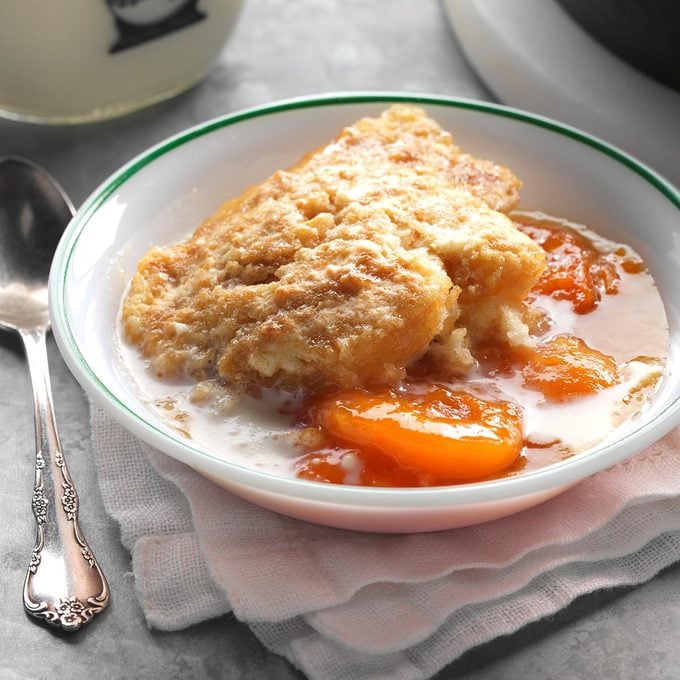
Skillet Caramel Yellowish pink Grunt
Here's an onetime-fashioned larder dessert made with items you can easy continue hand. Mix up a second batch of the dry ingredients for the dumplings to save a a couple of proceedings the next time you prepare it. —Shannon Roum, Cudahy, WI
Pumpkin Pie Icing Cream with Salted Caramel Sauce
Truthfully, I wishing those tea cosey flavors of Thanksgiving throughout the twelvemonth. This icecream has just the right balance of spices, and no matter when you stool information technology, you'll find yourself surrounded in the warmth and love that pumpkin vine pie has to offer up. —Angie Dugald Stewart, Memphis, Tennessee
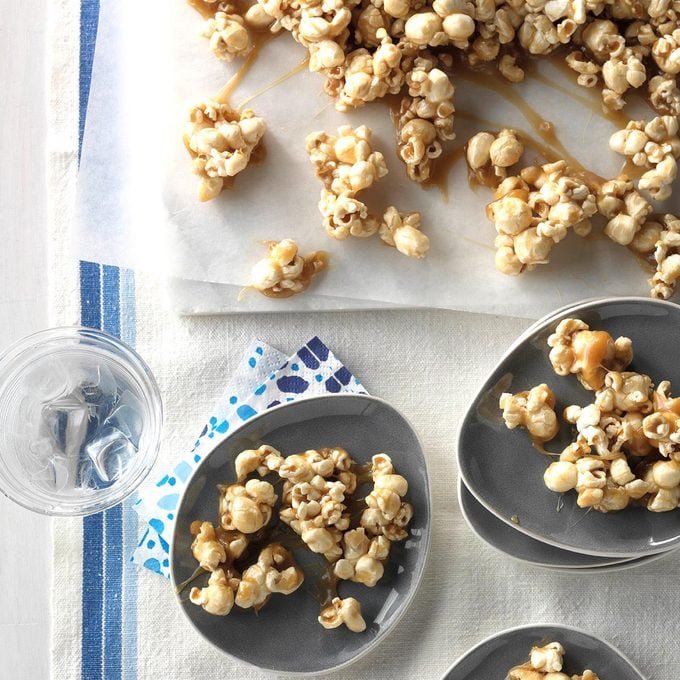
Chewy Raw sienna-Coated Zea mays everta
When I was a kid, my mom ready-made this formula often. I've adapted it to make it more tough and gooey than her crisp, nut-loaded rendering. I obtain requests to arrive at this for every event that I host, and have ne'er had a single remaining! —Shannon Dobos, Calgary, Alberta
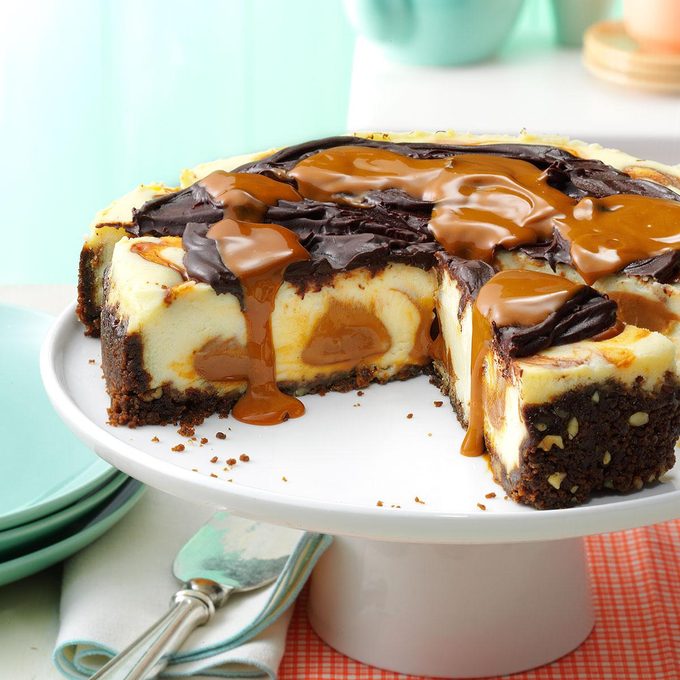
Dulce Delaware Leche Cheesecake
I'm originally from Republic of Paraguay, and dulce de leche reminds me of where I came from. If you can't find it at your grocery store, effort caramel ice cream topping instead. IT tastes different, but this decadent dessert wish still atomic number 4 awesome. —Sonia Lipham, Ranburne, Alabama
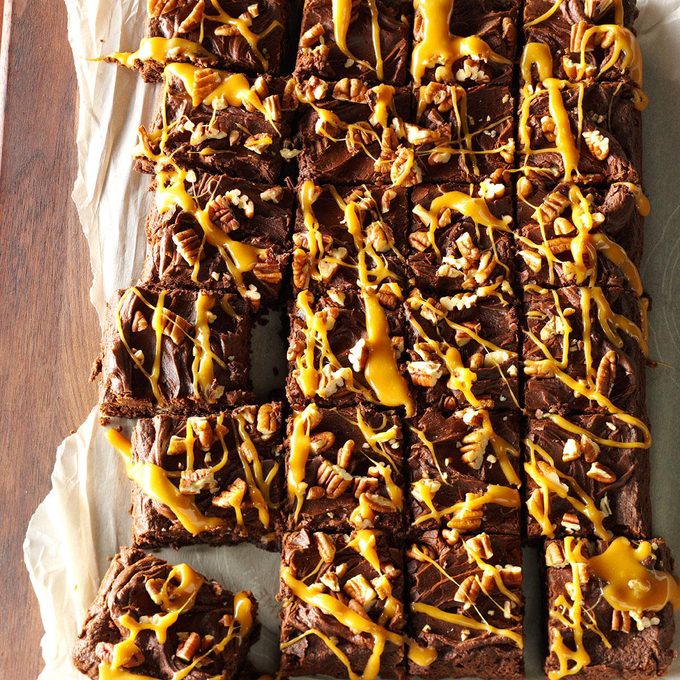
Turtle Brownies
Homemade turtle brownies are a sweet addition to the appetizer table on game day. Your guests might leave the score, but I guarantee they'll remember these treats! —Sherry Miller, Columbia High, Minnesota
Or try this classic turtle candy formula!
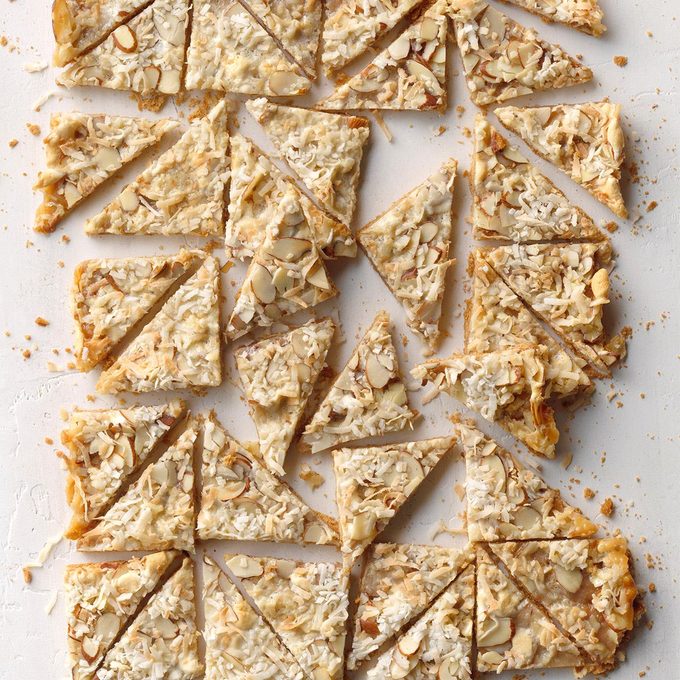
Caramel Heavenlies
Before I emasculated these bars into triangles, I usually trim the edges so all the cookies will look the same. My husband and daughter bon that part since they get to eat the refuse. —Dawn Burns, Lake St. Louis, Show Me State
Orchard apple tree Pie in vogue
This pie in style is a family unit favorite that combines apple pie filling and butter pecan ice cream with caramel topping and chopped nuts. I created it when trying to think up a comfortable dessert to complete a dinner party menu. —Trisha Kruse, Eagle, Idaho
Salted Cashew & Caramel Chews
Zip says "welcome home" like excitable, gooey, chewy cookies decent out of the oven with a cold glass of milk—mmm, heaven. You don't need a plate. Just grab and go. —Paula Marchesi, Lenhartsville, Pennsylvania

Salted Caramel Cappuccino Cheesecake
After spending years realistic in Seattle, I've become a deep brown junkie! I had to relocate across the country for a time, sol I created this cheesecake with the flavors of salted caramel, coffee and espresso. It lifted me up happening days when I felt up blue about leaving one of the world's amazing coffee destinations. —Julie Merriman, Seattle, Evergreen State
Caramel Nut Bars
No one can resist these chewy caramel brown and chocolate bars with a delightful oat crust and topping. They make a tantalizing dessert or a special snack anytime. These rich bars are double-dyed for a potluck since a little goes a long way. —Pat Hills, South Dayton, Newfangled York
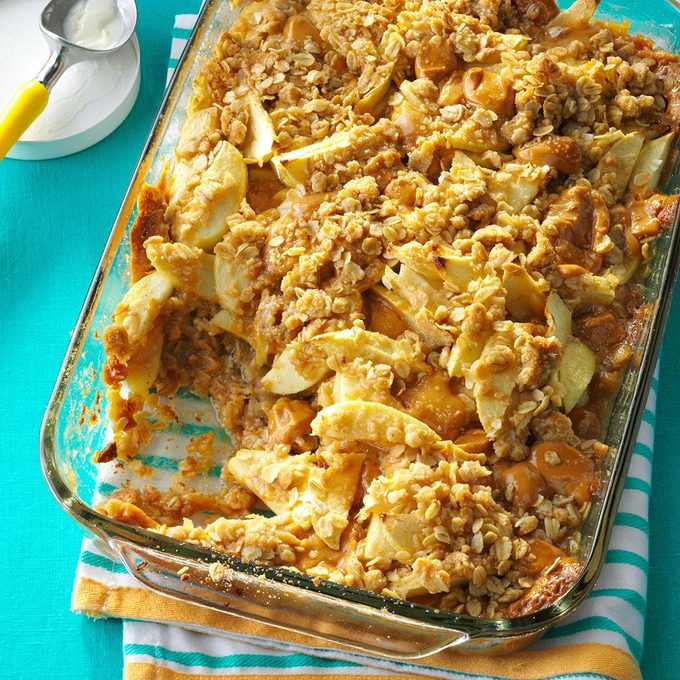
Contest-Winning Caramel Apple Crisp
When my kids and I make apple crisp, we use all sorts of apples to hike the flavor and texture. Add melted caramels, and you've got something scrumptious. —Michelle Brooks, Clarkston, Stop
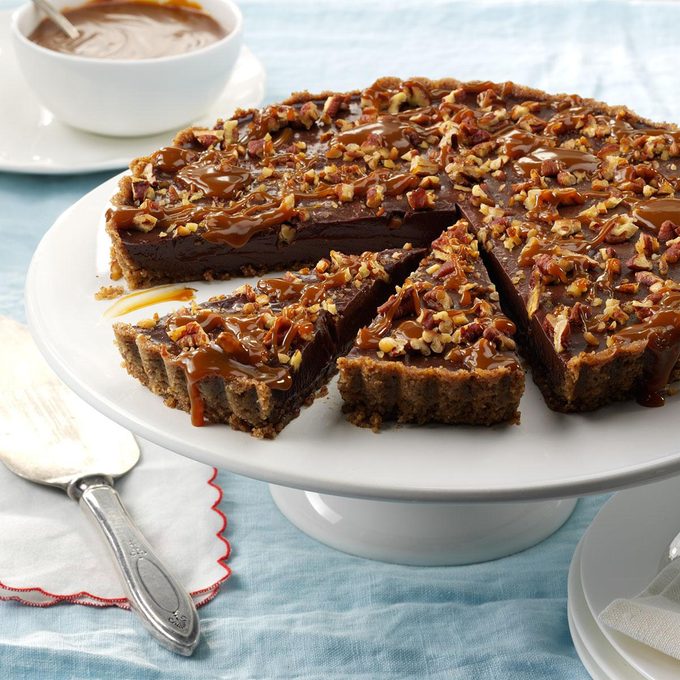
Turtle Tart with Chromatic Sauce
Between the creamy fill, crispy crust and gooey caramel sauce, at that place's a dish out to love about this sourish. Advantageous, you can arrive two to three days in advance. One of my daughters steady asks for this instead of cake on her natal day. —Leah Davis, Morrow, Ohio
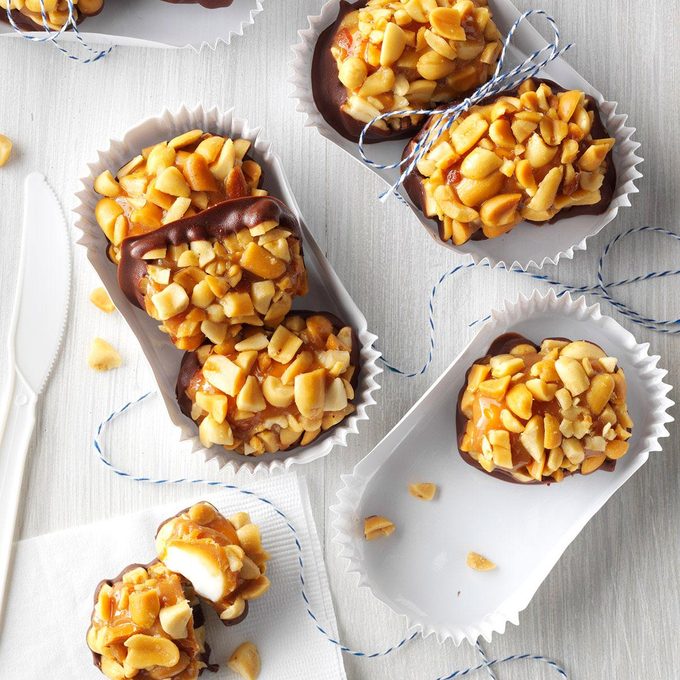
Salted Insignificant Rolls
A Christmas gift of homemade confect is always a make with sweet tooths. I dip these peanut rolls in chocolate, simply they're yummy plain, too. —Elizabeth Hokanson, Arborg, Manitoba
Candied apple Cheesecake
This apple cheesecake won the grand prize in an apple formula contest. With chromatic some on the tooshie and over the top, all bite is sinfully delicious. —Lisa Morman, Minot, North Dakota

Caramel Pecan Shortbread
My grandchildren spirit for Gran's "candy bar cookies" all Christmas. I commend double the formula for these unsoured treats because they cristal so fast. —Dorothy Buiter, Worth, Illinois
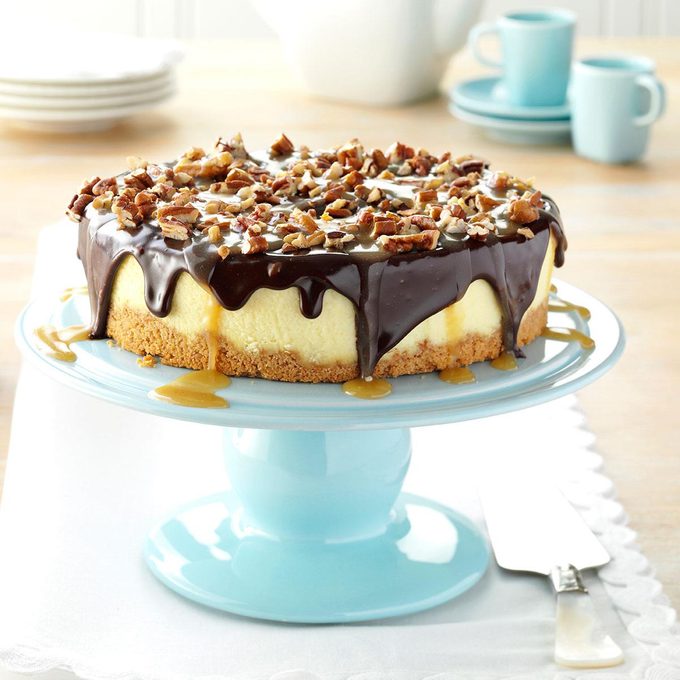
Simple Turn turtle Cheesecake
For an almost heartbeat dessert, I spread home-cured ganache and caramel sauce ended premade cheesecake. It always makes at work holidays feel slightly less hectic. —Laura McDowell, Lake Villa, Illinois

Apple Dumplings with Sauce
This warm and comforting orchard apple tree dumplings recipe is incredible by itself Beaver State served with icecream. You can decorate each dumpling aside cutting 1-edge leaves and a 1/2-inch stem from the unexhausted dough. —Robin Lendon, Cincinnati, Ohio
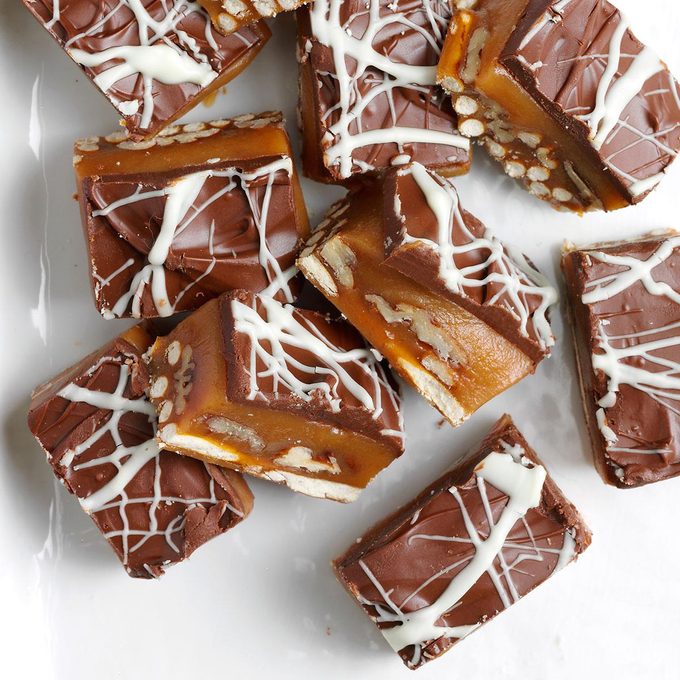
Yellowish brown Pretzel Bites
I created this recipe wanting to make my own version of a popular candy store pretzel log dipped in caramel, chocolate and insane. These bites are smothered with home-brewed caramel. —Michilene Klaver, Grand Rapids, Chicago

Yellowish brown Chocolate Piddle
A highlight of our annual family reunification is the dessert competitor. The judges take their jobs very seriously! Last year's first-put achiever was this enticing trifle.—Barb Hausey, Independence, Missouri

Blond Brownies a la Mode
Ever since I tried the maple blondie at Applebee's, I've been determined to work out the recipe. I tried several variations until I came up with this i, and information technology's get on one of our family favorites. —Pat Parker, Chester, South Carolina
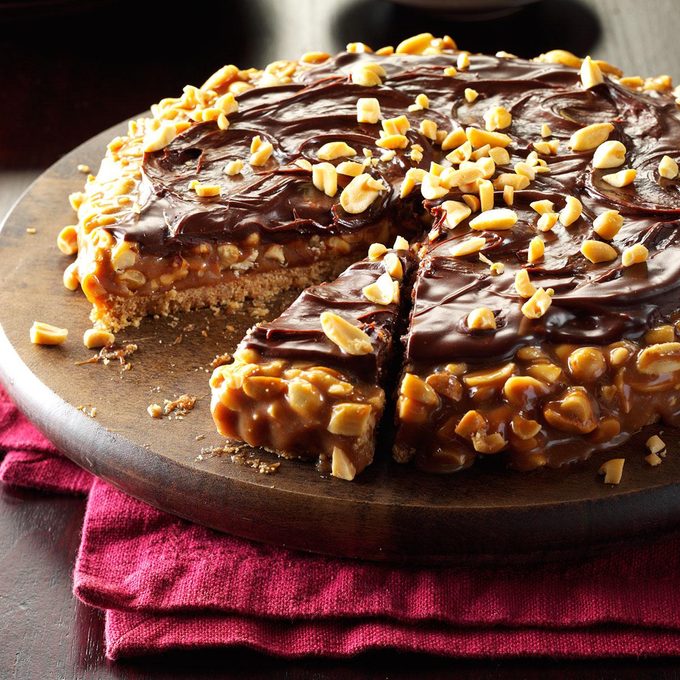
Caramel Peanut Fantasy
Jammed with peanuts and icky with yellowish brown, this arrange-onwards treat is one fragrant dream of a dessert to serve company. With an well-heeled cookie impudence and scrumptious candy bar layers, it goes put together quickly—and will disappear fair as fast! —Discernment of Home Test Kitchen, Milwaukee, Wisconsin River
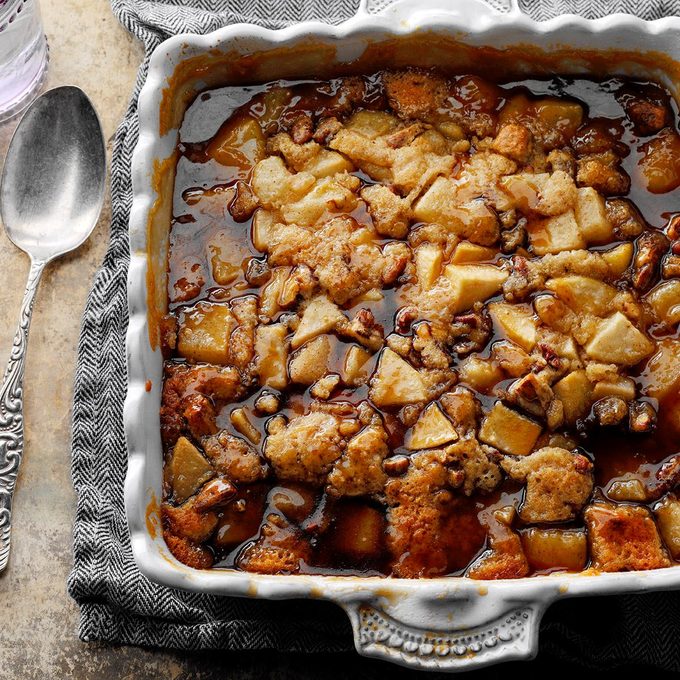
Chromatic Pear Pudding
Wear't expect this old-intentional dessert to last long. The delicate pears and irresistible caramel topping pass a winner whenever I serve it. It's nice to have a tempting precipitate cake that puts the flavour's best pears to excellent use. —Sharon Mensing, Greenfield, Iowa
Soft Tough Caramels
One of my first off experiences with cooking was portion my mother get to these caramels. We'd wee up to 12 batches each year. Nowadays, I do leastwise 95 percent of the cooking at home, but my wife does much of the baking hot. —Robert Sprenkle, Hurst, Lone-Star State

Shiny Glace Fruit Cookies
Even if your family doesn't care for fruitcake, they'll love life these festive cookies studded with candied fruit and pecans. A caramel brown glaze adds a delectable tinct on top. —Susan Hein, Burlington, Badger State
Caramel Malus pumila Float
World Health Organization doesn't have a go at it the flavors of caramel, apples, and vanilla ice cream together? If I'm feeling indented, I drizzle caramel syrup around the inside of my glass before adding the apple cider and powdered ginger ale. —Cindy Reams, Philipsburg, Pennsylvania
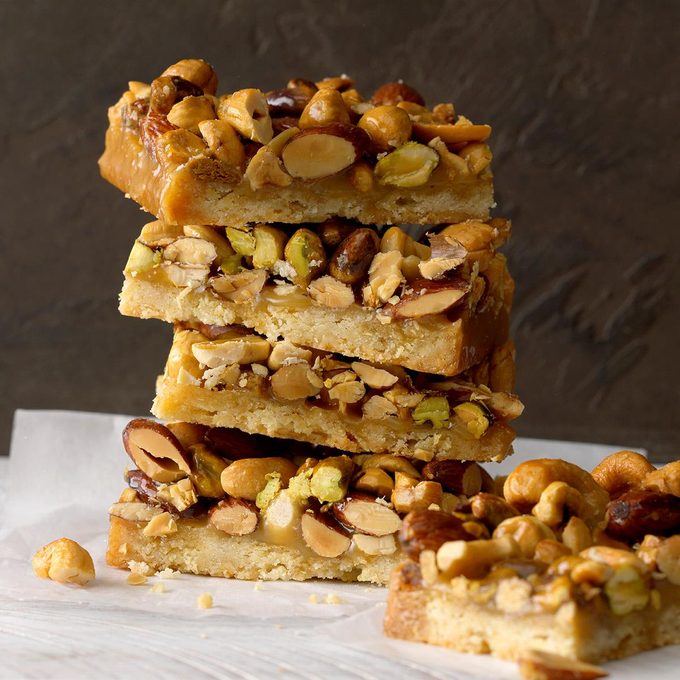
Hick Nut Parallel bars
My friends love crunching into these elastic, gooey bars that have a crust equivalent shortbread and a wildly nutty topping. —Barbara Driscoll, West Alosa alosa, WI

Caramel-Apple Skillet Clasp
My grandma old to bake a version of this for me when I was a trifle girl. She would make it exploitation fresh apples from her Tree in the backyard. I've adapted her formula because I have it away the combination of apples, pecans and buff. —Emily Hobbs, Springfield, Missouri
Cookout Caramel S'mores
These classic treats make a fabulous finish to an friendly repast. Toasting the marshmallows extends our after-dinner party time together, giving us something fun to do as a family. —Martha Haseman, Hinckley, Illinois

Apple Dumpling Wrap up-Ups
A family acquaintance gave Maine a simple way to make apple dumpling without lots of steps. I bang the embarrassing cinnamon top-hole. —Jenny Leighty, West Salem, Ohio
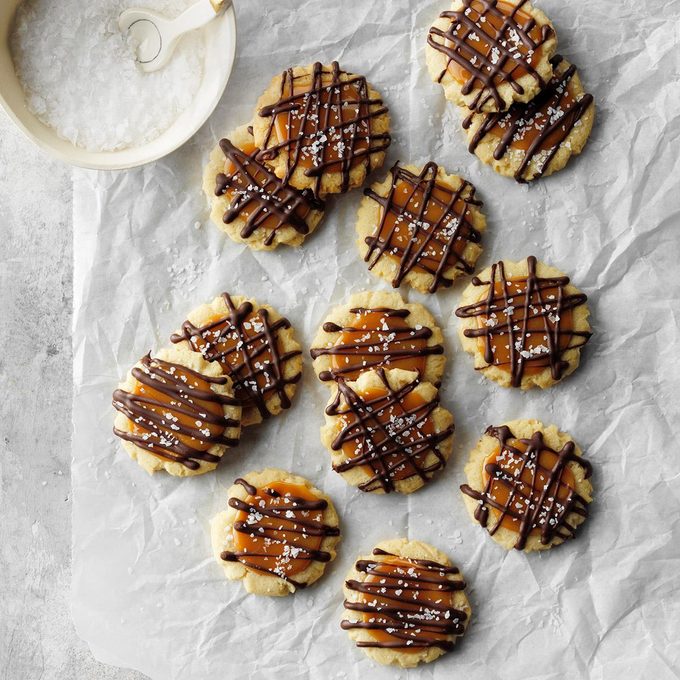
Buff Whiskey Cookies
A bit of yogurt replaces part of the butter in the traditional cookie, but you would never cognize. I get a mete out of requests for these and can't make a cookie tray without them. —Priscilla Yee, Concord, California

Classic Tres Leches Cake
Tres leches means "three milks." This cake gets its epithet because it uses three kinds of milk—evaporated, condensed and cream. This cake's light and airy texture has made it a classic in Mexican kitchens for generations. —Taste of Place Mental testing Kitchen
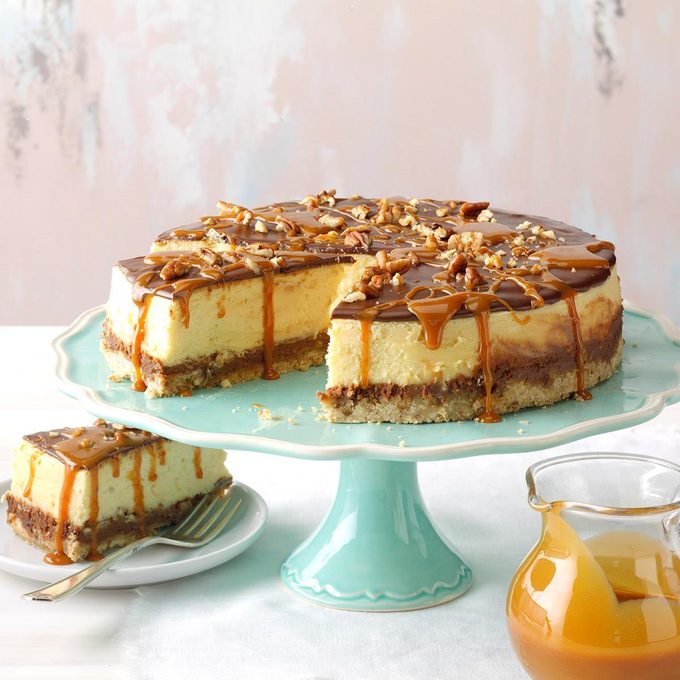
Superimposed Turn turtle Cheesecake
After receiving a quest for a specialised turtle cheesecake and non finding a good formula, I created my own. Everyone is thrilled with the results and this cheesecake remains a deary at the coffee shop where I work. —Sue Gronholz, Beaver Decameter, Wisconsin
Salt-cured Soft Caramels
Velvety smooth homemade caramels hold a sprinkling of kosher sharp to create a sweet-salty sense experience. Best of totally, these caramels don't pick up all to glucinium wrapped in waxed paper or plastic wrap...a selfsame tedious chore. The passionate caramel is poured into miniature gem liners instead. —Kathryn Joseph Conrad, Milwaukee, Wisconsin
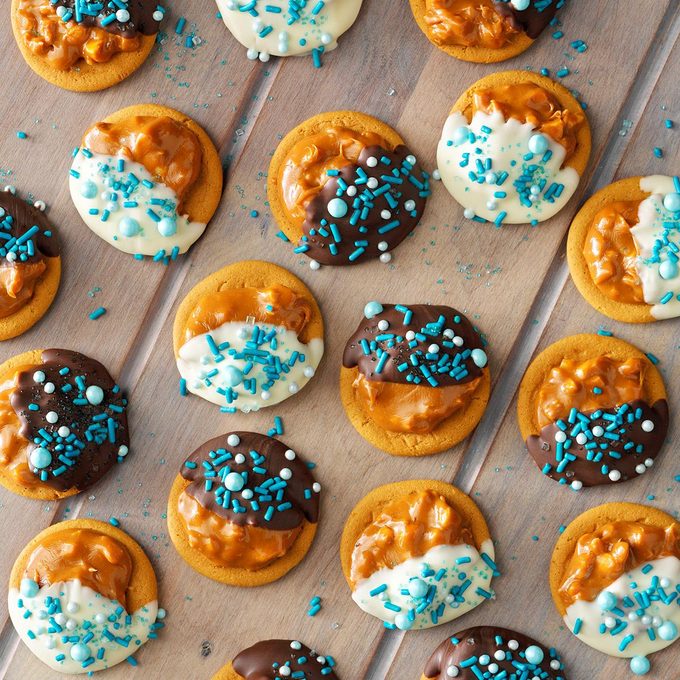
Gooey Caramel-Topped Gingersnaps
Making these cookies is therapeutic for me. And they are always rather popular at fundraisers. If you'd suchlike, you can make variations aside using different nuts. —Deirdre Cox, Kansas City, Missouri
Caramelized Ananas comosus Sundaes
Whenever we obtain a craving for a tropical dodging, this super simple recipe whisks us away in no time. Vanilla's nice but drizzling the sauce over salted caramel ice cream and taking a raciness is just pure paradise. —Elisabeth Larsen, Pleasant Grove, Utah
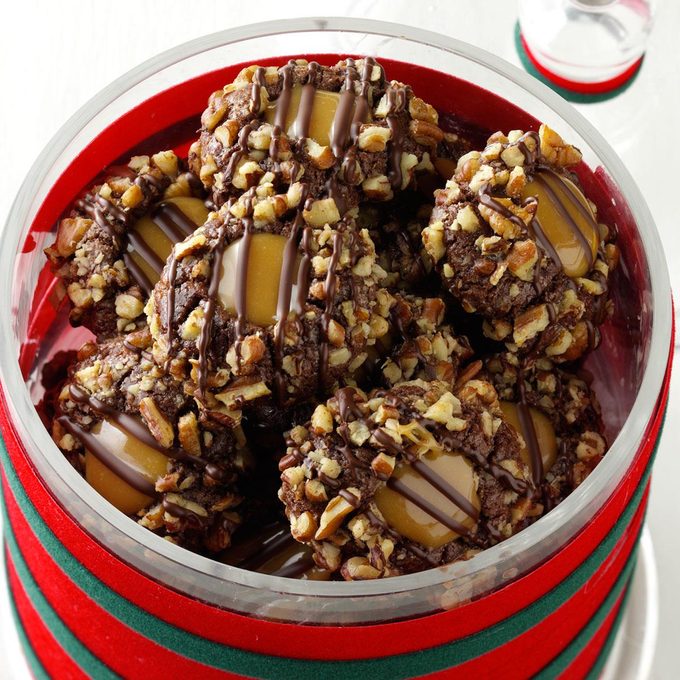
Chocolate Caramel Thumbprints
Covered in chopped around the bend and drizzled with hot chocolate, these cookies are scrumptious and pretty, likewise. Everybody looks forward to munching on them during the holidays. —Elizabeth I Marino, San Juan Capistrano, California
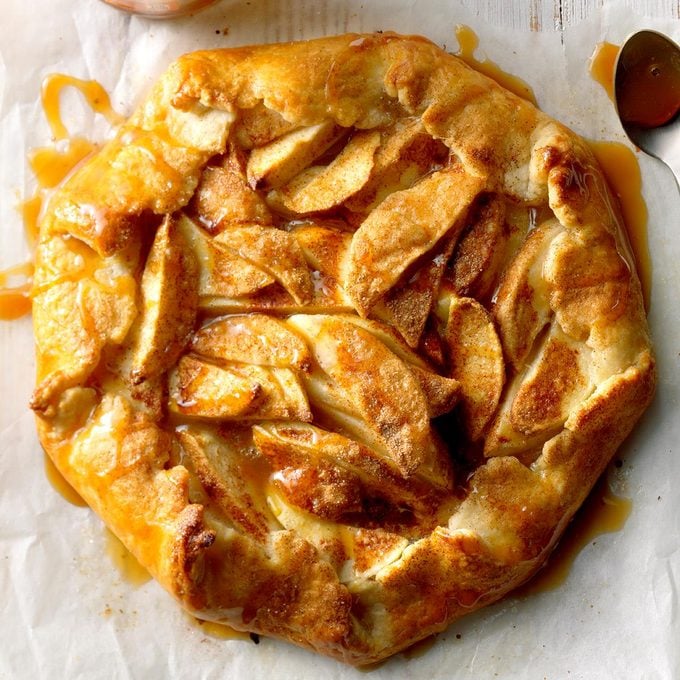
Rustic Caramel Apple Tart
Like an orchard apple tree pie without the pan, this delicious sporting lady has a tender crust that cuts nicely and a yummy caramel top-hole. —Betty Fulks, Onia, Arkansas
Capsize Cookie Cups
For a twist, utilize E. B. White chocolate chips in the cups and drizzle with white umber. — Heather Business leader, Frostburg, Maryland
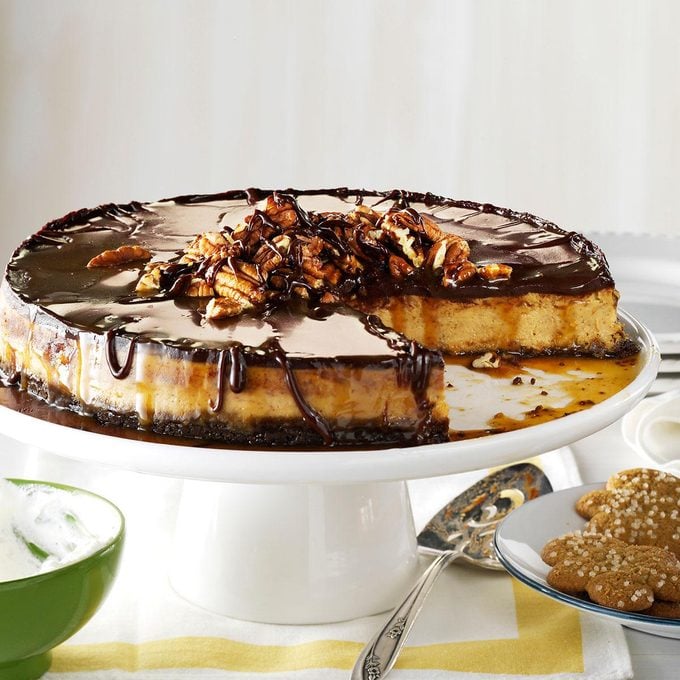
Gingerbread Cheesecake
This is my sophisticate on Christmas gingerbread...cheesecake-style! I like to garnish it with small gingerbread men all the way around the sides and a dollop of whipping cream connected each slice. —Cindy Romberg, Mississauga, Ontario

Glazed Orchard apple tree-Maple Blondies
My 6-year-stale Logos and I conjured upbound this formula to use up the last of the apples we picked from the local apple orchard. Each bar goes beautifully with a dollop of sweetened whipped cream. —Heather Bates, Athens, Maine

Apple Simoleons Pudding with Raw sienna Sauce
This orchard apple tree bread pudding with caramel sauce has been in my life for a long time. It's a family fave and always happening my buffet when I conjointly a brunch. It's also primary enough for dinner dessert. —Cleo Gonske, Redding, California
Taffy apple Bars
These parallel bars make an excellent fall dessert. We like to warm individual servings in the microwave and serve with a scoop of vanilla ice cream. It quickly became a family favorite; maybe it'll get over one of your family's, too. —Carol Stuber, Osawatomie, Kansas
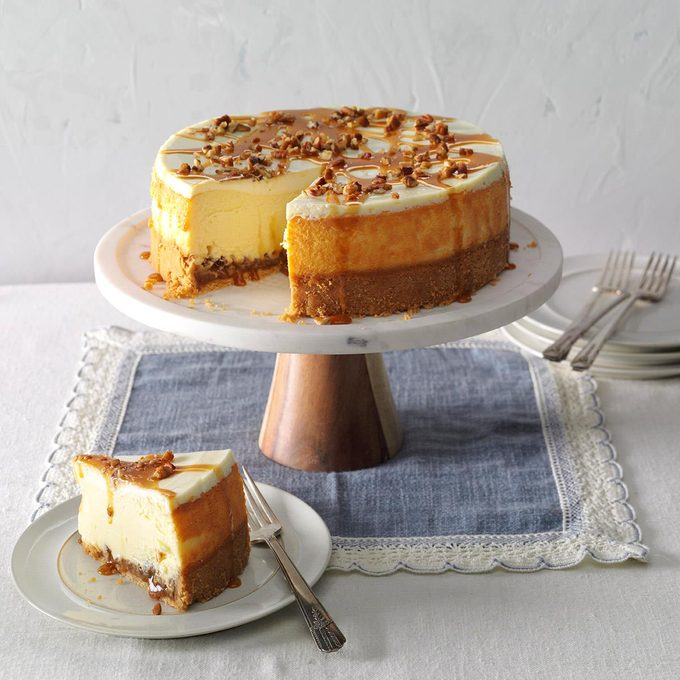
Caramel Pecan Cheesecake
I created this creamy cheesecake using cardinal of my favorites—caramel and pecans. It is a stunning cake and rivals any I've tasted. —Deidre Sizer, Cedarville, Ohio
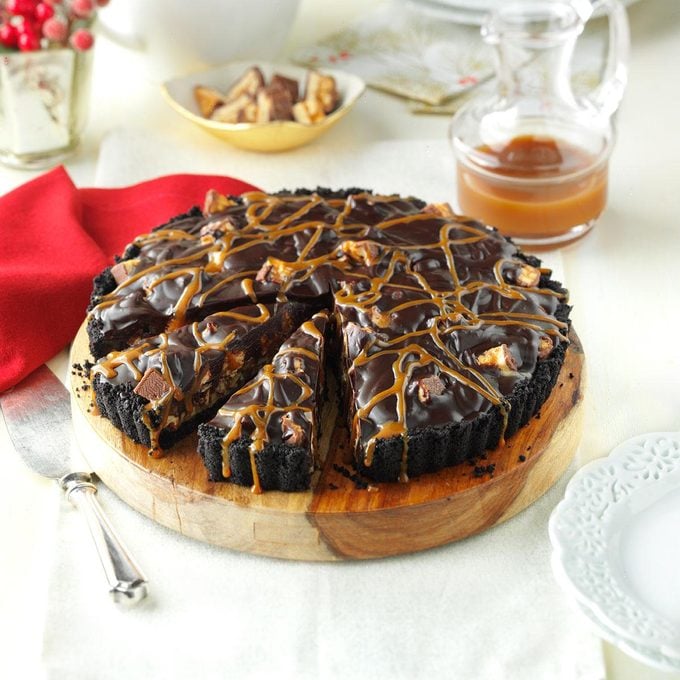
Fudgy Turtle Pie
Turtle pie is a truly decadent afters recipe everyone needs. We bang to integrate chocolate, caramel and crunchy candy bits in a pie that's ooey-gooey fabulous. —Dolores Vaccaro, Pueblo, Colorado































